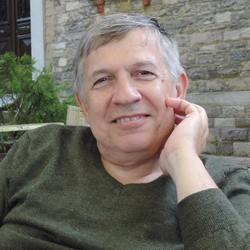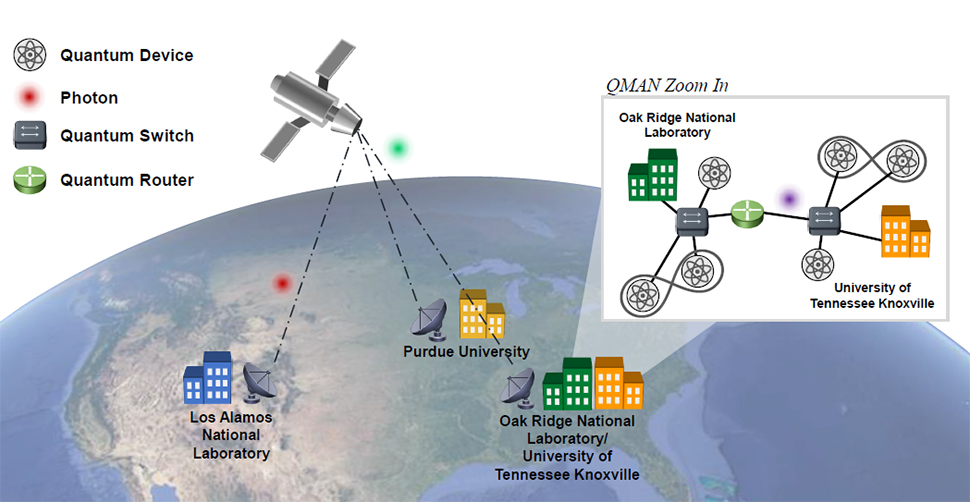Building a Broader, More Secure Internet
George Siopsis has never shied away from bits and bytes and the way they work. He’s always seen their broad potential: from running calculations underpinning theoretical physics to the opportunities advanced computing holds for Appalachia. Working with colleagues from national labs, other universities, and the private sector, he’s playing a lead role in a multimillion-dollar project from the United States Department of Energy (DOE) to develop and expand secure quantum networks—a building block for new scientific infrastructure.
DOE recently announced a $61 million investment in quantum information science, including $25 million to create quantum internet testbeds. Siopsis, a professor in the physics department, is a co-principal investigator on one of the projects: Quantum-Accelerated Internet Testbed, or QuAInt. Nicholas Peters of Oak Ridge National Laboratory is the project lead, with deputy and co-PIs from Los Alamos National Laboratory, Purdue University, Amazon Web Services, and Qubitekk, founded by UT alumnus Duncan Earl. The goal is to devise, develop, and demonstrate a regional scale quantum internet testbed.

George Siopsis
In classical computers, processors are driven by chips most often made from silicon. Bits compose bytes, bytes store data, and chips house the memory and transistors powering the whole business in an integrated circuit.
Quantum computers, however, rely on more diminutive systems like atoms, photons, or electrons. While the laws of physics govern how atoms and light typically behave, things change at the quantum level, where the stage and the players are much, much smaller. In quantum mechanics, if particles ever interact their properties stay connected long after they part ways. This is called entanglement. Add to that the wonder of superposition, where a quantum particle can be a combination of all possible states. This is the heart of a qubit—a quantum bit—the engine of quantum computing and hence, a quantum internet.
This is familiar territory to a physicist like Siopsis.
"Currently, almost all people working in quantum communications are physicists," he said. "This is because this is emerging technology and to make any contributions, one needs to have a good grasp of quantum mechanics and optics. We are trying to change that to include electrical engineers, computer scientists, and other disciplines. I am working with both (the) Arts and Sciences and Engineering colleges to develop the right interdisciplinary curriculum."
Among Siopsis’s tasks is to help build a secure network from the ground up to protect its infrastructure from future threats and to expand that network once it takes shape. He has experience in quantum security through research for the U.S. Navy and has an on-campus lab suited to the task.
"Our quantum optics laboratory was built to perform research in quantum-secure communications through optical fibers (wired) as well as free space (wireless)," he said.
Siopsis explained that quantum security is enabled with quantum key distribution (QKD). A crucial element of QKD is that it alerts two users when a third party is trying to eavesdrop. Working with UT-ORNL joint faculty members Bing Qi and Raphael Pooser, his group developed measurement-device-independent (MDI) QKD, which can accommodate untrusted relays in the quantum network. They also collaborated with the National Institute of Standards and Technology, who provided two telescopes for long-distance wireless communications.
"In QuAInt, we will take the network out of the lab and start building a quantum internet, starting with a quantum local area network (QLAN), and working up to a quantum metro area network (QMAN) demonstrating quantum entanglement at inter-city level," Siopsis said. "We will use fibers for short distances and telescopic instruments and low earth orbit satellites for long distances. Our lab will be one of the nodes in the quantum internet we are building."

While Siopsis is building the network, Duncan Earl will be working on translating QuAInt’s research gains into commercial successes. He’s the founder, president, and chief technology officer of San Diego-based Qubitekk.
Duncan Earl (courtesy of Qubitekk)
"We make commercially available quantum entangled photon sources," he explained. "When you think about a quantum network or any of the material development that they’re going to be doing related to quantum internet, the entangled photon sources are a really critical piece of that."
While ORNL and UT can build much sleeker sources, he said, "our sources are really rugged, and we can crank out thousands of them."
Rather than waiting on a perfect source to jump into the industry mainstream, Qubitekk can start where they are and incorporate progress as it develops, accelerating the timeline from research to market.
"We can bring that really rugged source to this project and as improvements occur, which we definitely believe will happen with this project, we can very easily license that from UT and ORNL, incorporate that into our commercial source, and make our source better. With any of these projects the push is really about getting technology out into the marketplace and taking basic science and turning it into profits eventually."
A UT graduate, Earl earned a bachelor’s degree in engineering physics and a master’s in physics, as well as a PhD in electrical engineering. He worked for ORNL before founding Qubitekk in 2013 and has maintained his ties to both the national lab and the university.
"It’s great to have the strong connections of being a UT graduate, then working at ORNL, then having my own business in quantum," he said. "There’s this strong personal connection; it’s friendships and professional relationships all tied together that allow everyone to trust each other and help that partnership work better."
Earl is also working with colleagues in Chattanooga and sees a lot of potential for this kind of collaborative spirit in Tennessee and the Southeast as a whole given the confluence of ORNL, universities, and economic support.
That attitude folds nicely into another of Siopsis’s endeavors: the Appalachian Quantum Initiative. The goal is to lift the region by leveraging the quantum and supercomputing strengths of UT and ORNL to develop a future workforce in quantum information science with the support of regional industry and national labs, building a research infrastructure for Appalachia. His work with QuAInt is another positive step in that direction.
"These efforts bode well for my Appalachian Quantum Initiative," he said.